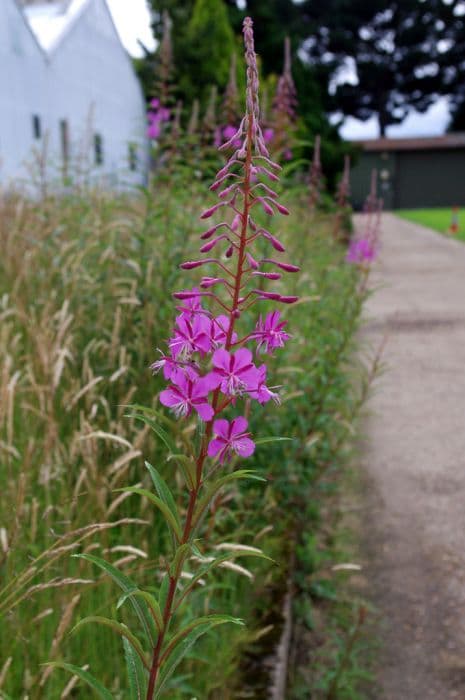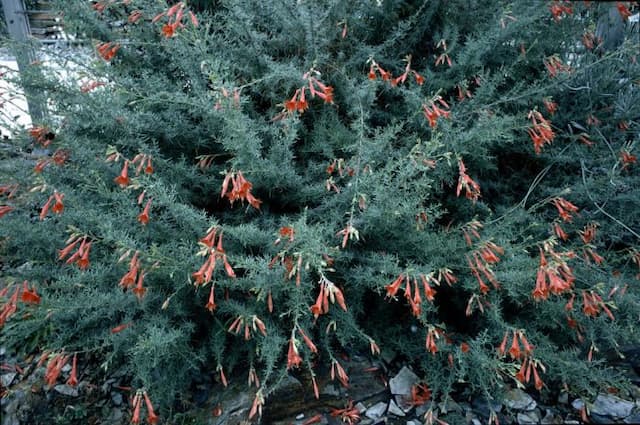White Bolivian Fuchsia Fuchsia boliviana Carrière var. alba

ABOUT
The Fuchsia boliviana Carrière var. alba, commonly referred to as the white Bolivian fuchsia, is a striking plant with an elegant form that captivates the eye. This variety is known for its lush green foliage which is comprised of long, slender leaves that have a slightly droopy appearance, giving the plant a graceful, cascading look. The most remarkable feature of the white Bolivian fuchsia is its flowers. The blooms are long, tubular, and pendulous, resembling dainty hanging lanterns. They show an exquisite combination of colors, typically a delicate white with hints of pale green at the tips, transitioning into a blush pink or light red at the base. The interiors of the flowers often exhibit a subtle shade of purple, adding depth and complexity to their beauty. These blossoms are arranged in clusters, which can be quite profuse, creating an opulent display of color. Furthermore, the plant is adorned with red to purple-toned fruits that follow the flowering season. These small, elongated berries contrast beautifully against the green foliage, adding yet another layer of visual interest to the plant. The overall appearance of the white Bolivian fuchsia is one of ornamental charm that can bring a sense of delicate sophistication to any garden setting.
About this plant
 Names
NamesFamily
Onagraceae
Synonyms
Alba Fuchsia, White Bolivian Fuchsia, Hummingbird Fuchsia, White Fuchsia Boliviana
Common names
Fuchsia boliviana var. alba (Carrière) L.H. Bailey.
 Toxicity
ToxicityTo humans
Fuchsia boliviana, commonly referred to as Bolivian Fuchsia, is not considered toxic to humans. In fact, the berries of some fuchsia plants are edible when ripe. However, ingesting any non-edible parts of the plant, especially in significant quantities, could potentially cause mild gastrointestinal irritation or discomfort for some individuals. It is advisable to consume only parts of the plant that are known to be safe and to consult a healthcare professional if any adverse reactions occur after ingestion.
To pets
Bolivian Fuchsia is generally considered non-toxic to pets, including cats and dogs. While it is always best to prevent pets from eating plants as a precaution, there is no well-documented evidence of toxic effects attributable to this particular variety of fuchsia. If a pet were to ingest a large amount of the plant, mild gastrointestinal upset could possibly occur. If you observe unusual symptoms in your pet after ingestion, such as vomiting or diarrhea, it is recommended to consult a veterinarian.
 Characteristics
CharacteristicsLife cycle
Perennials
Foliage type
Evergreen
Color of leaves
Green
Flower color
White
Height
10 feet (3 meters)
Spread
5 feet (1.5 meters)
Plant type
Shrub
Hardiness zones
9
Native area
Bolivia
Benefits
 General Benefits
General Benefits- Ornamental Value: Fuchsia boliviana Alba is prized for its long tubular white flowers that add aesthetic appeal to gardens and landscapes.
- Attracts Pollinators: The plant is known to attract hummingbirds and bees, which are essential for the pollination of many other plants.
- Shade Tolerance: The plant can thrive in partial shade, making it suitable for areas under trees or in the shadow of buildings.
- Cooling Effect: Its foliage and flowers can contribute to a cooling effect in gardens, providing a refreshing environment during hot weather.
- Ease of Propagation: It can be easily propagated from cuttings, allowing gardeners to multiply their plants without the need for buying new ones.
- Long Blooming Period: Fuchsia boliviana Alba has a long flowering season, which ensures a continuous display of flowers for an extended period.
- Versatility: The plant can be grown in containers, making it suitable for balconies and patios, as well as indoor environments with appropriate care.
 Medical Properties
Medical PropertiesThis plant is not used for medical purposes.
 Air-purifying Qualities
Air-purifying QualitiesThis plant is not specifically known for air purifying qualities.
 Other Uses
Other Uses- Fuchsia boliviana flowers can be used as a natural dye, providing a subtle pink hue to textiles or handmade papers.
- The plant is often cultivated for ornamental purposes due to its striking white flowers, adding aesthetic appeal to gardens and homes.
- Fuchsia fruits are edible and can be made into exotic jams, jellies, or desserts, giving a unique flavor from the high altitudes of South America.
- Incorporated into landscaping, Fuchsia boliviana can provide living shade in small corners of the garden with its bushy growth habit.
- Dried Fuchsia flowers are utilized in potpourri for their shape and delicate color, enhancing the visual attractiveness of the mixture.
- Fuchsia boliviana can be used for educational purposes in botany and horticulture, illustrating plant care and propagation techniques.
- Fuchsia hedges can be cultivated from these plants to create natural, flower-laden boundaries or dividers in outdoor spaces.
- The plant's nectar-rich flowers can attract pollinators such as hummingbirds and butterflies, promoting biodiversity in the garden.
- Used in floristry, Fuchsia boliviana stems can add an exotic touch to bouquets and floral arrangements due to their drooping flower clusters.
- As a subject of botanical illustration and photography, the plant provides an opportunity for artists to capture its intricate flower structures.
Interesting Facts
 Feng Shui
Feng ShuiThe Fuchsia is not used in Feng Shui practice.
 Zodiac Sign Compitability
Zodiac Sign CompitabilityThe Fuchsia is not used in astrology practice.
 Plant Symbolism
Plant Symbolism- Confiding Love: Fuchsia flowers, in general, are associated with confiding love. The drooping nature of the flowers suggests humility and a deep emotional connection.
- Elegance and Good Taste: With its exquisite appearance, the white variety of Fuchsia boliviana symbolizes elegance and good taste. Its refined beauty is often admired in ornamental gardens and floral arrangements.
- Amiability: The soft, appealing shades and graceful growth of the Fuchsia boliviana Carrière var. alba exemplify amiability, suggesting a welcoming and friendly energy.
- Trustworthy: Fuchsia blooms can signify trust, with their intermingling colors representing the blend of two hearts that trust each other.
 Water
WaterAlba Fuchsia should be watered thoroughly whenever the top inch of soil feels dry to the touch. On average, this could mean watering the plant every 7 to 10 days, but the frequency will vary depending on the humidity and temperature of the environment. Water the plant slowly, allowing the water to seep through to the roots, using about 1 to 2 gallons for a medium-sized pot. Avoid letting the pot sit in water, as fuchsias do not like to be waterlogged. During the active growing season, in spring and summer, the Alba Fuchsia will require more frequent watering than in the fall and winter.
 Light
LightAlba Fuchsia thrives in bright, indirect light but can also tolerate some morning sun. The ideal spot for this plant is a location where it receives diffused sunlight, such as behind a sheer curtain or in a well-lit room. Direct afternoon sunlight should be avoided as it can scorch the delicate leaves of the plant. A north-facing or east-facing window makes for a suitable position.
 Temperature
TemperatureAlba Fuchsia prefers a cool to moderate temperature range, ideally between 55 and 75 degrees Fahrenheit. It is important to protect the plant from extreme temperatures; the Alba Fuchsia can survive brief exposures to temperatures as low as 40 degrees Fahrenheit and as high as 80 degrees Fahrenheit, but prolonged exposure to these extremes can be damaging. The ideal growing conditions are cool nights and mild daytime temperatures.
 Pruning
PruningPrune Alba Fuchsia to maintain its shape and encourage bushier growth. This should be done in the late winter or early spring before new growth begins. Pruning can include removing dead or weak branches and pinching back the tips of stems to promote branching. Pruning can be done again after flowering to remove spent flowers and seedpods, which helps increase the following season's blooms.
 Cleaning
CleaningAs needed
 Soil
SoilFuchsia boliviana 'Alba' prefers a soil mix that is well-draining and rich in organic matter with a slightly acidic to neutral pH of 6 to 7. A mix of one part peat moss, one part loam, and one part perlite or sand is ideal to provide the necessary balance of moisture retention and drainage. Regular feeding with a balanced, water-soluble fertilizer during the growing season will keep the soil fertile.
 Repotting
RepottingFuchsia boliviana 'Alba' should be repotted every two to three years or when the plant becomes root-bound. The best time to repot is in the late winter or early spring before new growth starts. Use fresh soil mix as described and make sure the new pot is only slightly larger than the old one.
 Humidity & Misting
Humidity & MistingFuchsia boliviana 'Alba' thrives best in high humidity conditions, ideally around 60-70%. To maintain these levels, especially indoors, consider using a humidity tray with water or a room humidifier, and mist the plant regularly without making the soil waterlogged.
 Suitable locations
Suitable locationsIndoor
Place Alba in bright, indirect light and keep soil moist.
Outdoor
Plant Alba in partial shade with shelter from wind.
Hardiness zone
9-11 USDA.
 Life cycle
Life cycleFuchsia boliviana Carrière var. alba, commonly known as Alba fuchsia or Bolivian fuchsia, starts its life cycle when seeds germinate, typically in moist, well-draining soil and under partial shade. The seedlings develop into juvenile plants characterized by their fast-growing, bushy nature and the early formation of their signature lanceolate leaves. As the plant matures, it begins to produce its distinct long, tubular white flowers with red sepals, typically observed during the warmer months. Following pollination, which is often assisted by hummingbirds, the flowers develop into elongated, berry-like fruits. Alba fuchsia's fruits mature to a reddish-purple color, indicating the seeds inside are ready for dispersal, which can be through animal consumption or mechanical means. Upon reaching the end of its life, the plant will senesce and die, completing its life cycle, although it can live for many years if provided with proper care and favorable conditions.
 Propogation
PropogationPropogation time
Spring-Early Summer
Fuchsia boliviana Carrière var. alba, commonly known as White Bolivian Fuchsia, is a shrub that is most effectively propagated through softwood cuttings, a practice that is best undertaken in late spring through to summer. To propagate via cuttings, one would typically take a non-flowering shoot of about 4 to 6 inches (10 to 15 cm) in length, ensuring several sets of leaves are present. The lower leaves are removed, and the cut end is often dipped in a rooting hormone to encourage root development. This cutting is then inserted into a well-draining soil mix, ensuring at least two sets of leaf nodes are below the surface. The environment should be kept humid by covering the pot with a plastic bag or placing it in a propagator, and it should be kept out of direct sunlight. Roots usually develop within 3 to 4 weeks, at which point the new plants can be gradually acclimatized to outdoor conditions if the climate is appropriate.









